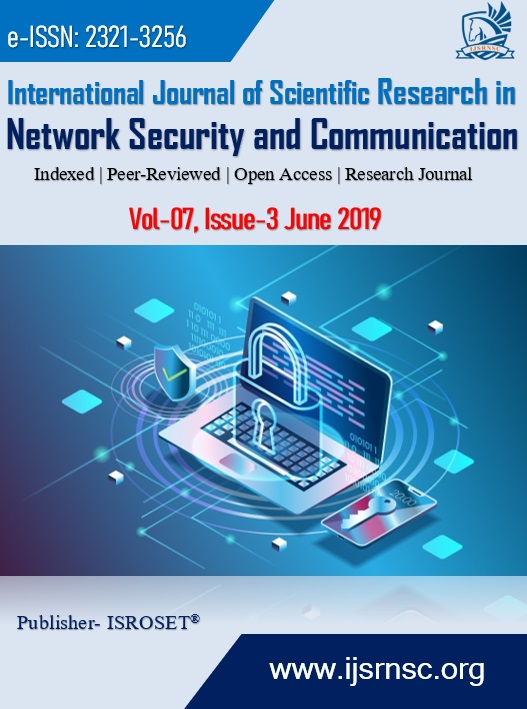A Proposed Model for Enhanced Security against Key Reinstallation Attack on Wireless Networks
Keywords:
Wireless Protocol Access, Wireless Local Area Networks Security, Pire-wise Transient KeyAbstract
Wireless network security is advancing consistently. This progress can be easily seeing by recounting the success stories achieved through the years since the modification of its first security protocol, WEP; then the WPA and finally the WPA2. The Wireless Protocol Access Pre-Shared Key (WPA2-PSK) mode is usually adopted by Small Office Home Office (SOHO) environments as it does not require a costly investment on a dedicated authentication system. Nevertheless, despite the fact that this mode was improved consistently, the core part (4-way handshake) still presents several vulnerabilities such as the key reinstallation attack (KRACK) which was discovered by Vanhoef and Piessens in 2016 and published in October, 2017. Here, we proposed an enhanced model which involved a Boolean variable that switches from true to false once the Key is installed; also, we include handshake messages encryption with Pair-wise Master Key as the encryption/decryption key, using Advance Encryption Standard (AES). Results obtained from the simulations of the enhanced model were compared with that of the existing model. The message execution time measured in micro seconds shows that the proposed model is more efficient than the existing four-way handshake model and it prevent the reinstallation of the Pair-wise Master key (PTK) during the handshake process.
References
Alblwi, S., & Shujaee, K. (2017). A Survey on Wireless Security Protocol WPA2. In International Conference Security and Management.
Alliance, W. F. (2001). Wi-Fi Protected Access: Strong, standards-based, interoperable security for today’s Wi-Fi networks. White paper, University of Cape Town, 492-495.
Arana, P. (2006). Benefits and Vulnerabilities of Wi-Fi Protected Access2 (WPA2). INFS 612–Fall.
Benton, K. (2010). The evolution of 802.11 wireless security. Journal, UNLV Informatics- Spring, n. INF, 795, 1-56.
Hailemariam, M. A. (2016). Securing the Transmission of Group Addressed Data Frames by Enhancing the IEEE 802.11i Security Protocol (Doctoral dissertation, Addis Ababa University).
He, C., & Mitchell, J. C. (2004). Analysis of the 802.11 i 4-Way Handshake. In Proceedings of the 3rd ACM workshop on Wireless security (pp. 43-50). ACM.
He, C., Sundararajan, M., Datta, A., Derek, A., & Mitchell, J. C. (2005). A modular correctness proof of IEEE 802.11 i and TLS. In Proceedings of the 12th ACM conference on Computer and communications security (pp. 2-15). ACM.
IEEE 802.11 Working Group. (2010). IEEE standard for information technology–Telecommunications and information exchange between systems–Local and metropolitan area networks–Specific requirements–Part 11: Wireless LAN Medium Access Control (MAC) and Physical Layer (PHY) specifications Amendment 6: Wireless Access in Vehicular Environments. IEEE Std, 802(11).
Kumkar, V., Tiwari, A., Tiwari, P., Gupta, A., &Shrawne, S. (2011). Vulnerabilities of Wireless Security protocols (WEP and WPA2). International Journal of Advanced Research in Computer Engineering & Technology (IJARCET), 1(2), pp-34.
Liu, Y. L., & Jin, Z. G. (2015). SAEW: A security Assessment and Enhancement System of Wireless Local Area Networks (WLANs). Wireless Personal Communications, 82(1), 1-19.
Naamany, A. M., Al Shidhani, A., &Bourdoucen, H. (2006). IEEE 802.11 wireless LAN security overview. In IJCSNS (Vol. 6, No. 5B, p. 138).
Naitik, T., Raiton L., Pradnya, V., & Vamshi, S. (2018). Mitigation of Key Reinstallation Attack in WPA2 Wi-Fi networks by detection of Nonce Reuse. International Research Journal of Engineering and Technology (IRJET), 5(5),pp-4.
Nikita, B., Ian, G., & David, W.(2001).Intercepting Mobile Communications. The Insecurity of IEEE802.11. 7th Annual International Conference on Mobile Computing and Networking, July 2001.
Nowicki, G. D. (2004). Wireless Security:The Draft IEEE 802. 11i Standard.
Ozasa, Y.,2007. A Study on the Tews-Weinmann-Pyshkin Attack Against WEP. IEICE Technical Report 2007, 2007: pp. 17-21.
Rajotiya, A. (2012). Enhancing Security of Wi-Fi Network (VOL. 3). International Journal of Computer Applications.
Scott R. F., Itsik, M., & Adi S. (2001). Weaknesses in the Key Scheduling Algorithm of RC4,” In Selected Areas in Cryptography , Vol. 2259 of Lecture Notes in Computer Science, pp. 1-24.
Singh, S., & Amit G. (2014). Study and Analysis of Dictionary attack and Throughput in WEP for CRC-32 and SHA-1. International Journal of Computer Applications 96.( pp. 15-18).
Sohail, A. (2010). WPA Too! Airtight Networks, DEF Conference 18
Stanley, D., Jesse W., & Bernard, A. (2005). Extensible Authentication Protocol (EAP). Method Requirements for Wireless LANs. Request for Comments 4017.
Vanhoef, M., & Piessens, F. (2013). Practical verification of WPA-TKIP vulnerabilities. In ASIA CCS. ACM (pp. 427–436).
Vanhoef, M., & Piessens, F. (2016). Predicting, Decrypting, and Abusing WPA2/802.11 Group Keys. In USENIX Security Symposium (pp. 673-688).
Vonhoef, M., & Piessens, F. (2017). Key reinstallation attacks:Forcing nonce reuse in WPA2. In Proceeding of the 2017 ACM SIGSAC Conference on Computer and Communications Security (pp. 1313 – 1328). ACM.
Xing, X., Shakshuki, E., Benoit, D., &Sheltami, T. (2008). Security analysis and authentication improvement for ieee 802.11 i specification. In Global Telecommunications Conference, 2008. IEEE GLOBECOM 2008. IEEE (pp. 1-5). IEEE
Downloads
Published
How to Cite
Issue
Section
License

This work is licensed under a Creative Commons Attribution 4.0 International License.
Authors contributing to this journal agree to publish their articles under the Creative Commons Attribution 4.0 International License, allowing third parties to share their work (copy, distribute, transmit) and to adapt it, under the condition that the authors are given credit and that in the event of reuse or distribution, the terms of this license are made clear.









